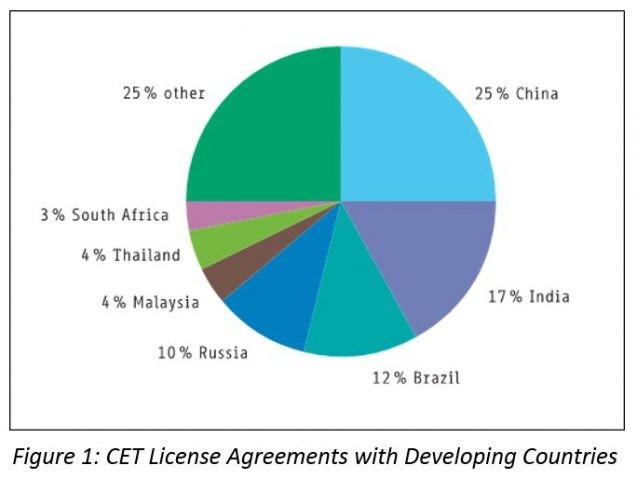Protecting Intellectual Property While Mitigating Climate Change: Can We Do Both?
Less than a year after its adoption, the Paris Climate Agreement has already been ratified by 77 countries, accounting for over 55 percent of global greenhouse gas emissions, and will enter into force on Nov. 4. Under the agreement, member countries recognize the need to reduce their greenhouse gas emissions, “in the context of sustainable development and efforts to eradicate poverty.”
Achieving this goal will require a major shift in global investment, production, and consumption patterns. This shift has already begun in industrialized countries, with the introduction of so-called “clean development” technologies, designed to reduce emissions while maintaining living standards. Unfortunately however, these technologies—which include large-scale solar, wind and other renewable energy systems—have been widely deployed in few developing countries, where they are essential to charting a sustainable, low-carbon pathway to development.
The global transfer of clean development technologies, particularly from industrialized to developing countries, is complicated by the intellectual property regime. Many of the technologies are subject to intellectual property rights, particularly privately-held patents, which give the holder exclusive rights in respect of the technology for a specified period (generally 20 years). During that period, third parties wishing to use the technology must obtain the consent of the patent holder, in the form of a license. The license will generally require the user to pay royalties or other fees determined by the patent holder. It may also contain other restrictions on use of the technology.
The impact of intellectual property rights on the dissemination of clean development technologies is highly contested. On one side of the debate are industrialized countries, who emphasize the benefits of these rights, arguing that patents provide a strong incentive for the development of new technologies. On the other side, developing countries argue that patents restrict their ability to access technologies that would allow them to address climate change, while improving living standards. They emphasize that most patents covering clean development technologies are owned by private sector entities in industrialized countries.
A 2010 study, led by the United Nations Environment Program (UNEP), found that 80 percent of patent applications for clean energy technologies, such as wind and solar energy systems, were filed in just six countries. Japan had the largest number of patent filings, followed by the U.S. and then Germany, Korea, the U.K., and France. This led the authors to conclude that “patenting in the selected clean energy technology fields is currently dominated by OECD [the Organization for Economic Cooperation and Development] countries.”
Patent activity is increasing in some developing countries, most notably China and India, which have become major players in the solar and wind energy sectors. These countries are outliers, however. Entities in other developing countries generally lack the financial resources and institutional capacity to invent patentable clean energy technologies. They may also find it difficult to license the technologies from other patent holders. A survey of 160 patent holders, conducted as part of the 2010 UNEP study, found that less than half (42 percent) had entered into licensing agreements with entities in developing countries in the previous three years. Just 5 percent of those surveyed indicated that they frequently enter into licensing agreements with developing countries, while 17 percent said they occasionally do and 25 percent said they rarely do.
The vast majority of clean energy technology license agreements benefit a small number of countries. Figure 1 (below), taken from the 2010 UNEP study, shows the percentage of agreements entered into with entities in various developing countries. As Figure 1 indicates, 64 percent of agreements are made with entities in China, India, Brazil, and Russia, the four richest developing countries. Agreements are rarely made with entities in poorer countries, including the 48 least developed countries. This is unfortunate as such countries have much to gain from the use of clean energy technologies. By way of example, developing countries could use solar and wind technologies to increase electricity access and thereby raise living standards, without worsening climate change.

Opinions differ as to why patented clean energy technologies are rarely licensed to entities in developing countries. Some have suggested that patent holders may be reluctant to license their technologies in developing countries due to inadequate protection of intellectual property rights, unfavorable market and investment conditions, and/or a lack of infrastructure and human capital. Others assert that it is because entities in developing countries are unable to afford the royalty payments demanded by patent holders. In this regard, the 2010 UNEP study found that available evidence “suggest[s] that companies from developing countries are facing some difficulties in obtaining technologies,” possibly due to “the high cost of licensing.”
Some developing countries have suggested that patent holders should be required to make clean energy technologies and other clean development technologies available under royalty-free licenses. Others have gone further, suggesting that patent protections for clean development technologies should be limited, or completely excluded. The latter proposal would raise issues under international treaties, particularly the World Trade Organization Agreement on Trade Related Aspects of Intellectual Property (TRIPS Agreement), which includes an obligation to grant patents in all fields of technology. Industrialized countries have vehemently opposed any change to the TRIPS Agreement and/or other treaties, which would weaken patent protections for clean development technologies, arguing that this would hinder technological innovation. Many developing countries are not convinced, however.
Tensions between industrialized and developing countries are likely to intensify in coming months, as countries begin to implement the Paris agreement and develop strategies to achieve the United Nations’ Sustainable Development Goals. Both industrialized and developing countries would likely agree that, to achieve the Paris agreement’s goals and the Sustainable Development Goals, action should be taken to remove impediments to the diffusion of clean development technologies arising under the international treaties.
But to what extent do treaties actually create such impediments? And how can they be removed? These questions will be explored at the Columbia International Investment Conference on Nov. 2 and 3. The conference will bring together both government and private sector actors to discuss the impact of international agreements on climate action. Readers wishing to join the discussion can register for the conference here.

